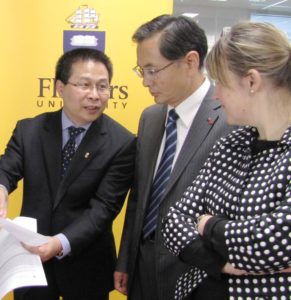
With 70% of the planet covered by oceans, the marine environment is one of the next big frontiers for discovering promising bioactive ingredients to launch new industries, food sources, biotechnology processes and even novel disease cures and treatments.
As well as improving aquaculture systems to supplement food supplies of popular wild-caught fish and shellfish, marine scientists are looking at other natural biological resources of the seas.
They are looking into the diverse range of dietary additives or ‘super foods’, pharmaceutical, industrial and even cosmetic applications from the rich realm of sea life.
Marine biotechnology is part of Australia’s and New Zealand’s national marine science plans, with Australia’s so-called marine ‘blue economy’ expected to be worth more than $100 billion within the next decade.
“The blue economy is a key strategy of research and industry development of many economies, including Australia, New Zealand, Europe, Indonesia, the USA and China,” says Professor Robert Saint, Deputy Vice-Chancellor (Research) at Flinders University.
“Marine biotechnology is a growing field of science as research looks towards the megadiversity of the world’s oceans for biological, chemical and bioproduct discovery.”
Industry players, including South Australian, Tasmanian and NZ seaweed and microalgae products, will join scientists from Flinders, the Australian Institute of Marine Science, the CSIRO and other Universities at the inaugural 1st Australia New Zealand Marine Biotechnology Society Symposium (14-15 April at Flinders at Tonsley, Adelaide).
Flinders University Professor Wei Zhang, who is president of the Australia NZ Marine Biotechnology Society, says Flinders is pioneering advanced biorefinery processing technologies to sustainably extract marine biomass from seaweeds, sponges and their associated bacteria, and convert microalgae into biofuels.
“We have found anti-cancer properties in some marine sponge extracts, anti-bacterial qualities in sea cucumber cells, and a wide range of food and industrial applications for brown and red seaweeds unique to the waters of southern Australia,” says Professor Wei Zhang, director of the Centre for Marine Bioproducts Development at Flinders.
“We’re working with several South Australian industries, including a seafood processor and a cosmeutical company, looking for novel applications for high-value marine bioproducts.”
Whyalla-based clean energy company Muradel has established a demonstration plant to make biofuel from microalgae, one of the most sustainable and renewable biomass commodities available from salt water.
Muradel chief executive officer Dr David Lewis will speak at the Flinders symposium on Thursday, and chief scientist Dr Leanna Reid will speak on Friday ahead of the International Blue Bioeconomy Industry Forum panel discussion.
Other speakers are Dr Helen Fitton, chief scientist Marinova, Professor Furneaux from NZ’s Victoria University Ferrier Research Institute, Dr Peter Nichols from CSIRO, Professor Tony Carroll from Griffith University and Professor Bernie Degnan from the University of Queensland.
Including emerging high-tech renewable energy projects, the National Marine Plan forecasts Australia’s total marine industries to double its economic contribution to around $100 billion by 2025.
With 85% of Australia’s population living within 50km of the coast, the term ‘blue economy’ has been coined to emphasise the significance of marine industries.
The global value of biomarine economies is approaching $250 billion a year, with marine bioresources such as algae, sea cucumber, squid, chitin, collagen and other substances being used in health foods, functional products, drugs and industrial biomaterials.
As well, protein from aquaculture (farmed seafood) is growing more rapidly than any other animal food sectors. It is expected to provide more than 35% of the world’s global protein market by 2020.

